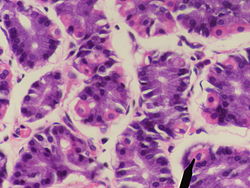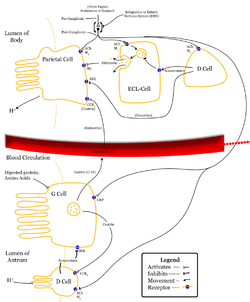- Parietal cell
-
Parietal cell 
Human parietal cells (pink staining) - stomach 
Control of stomach acid Latin exocrinocytus parietalis MeSH Gastric+Parietal+Cells Code TH H3.04.02.1.00033 Parietal cells, or oxyntic cells, are the stomach epithelium cells that secrete gastric acid and intrinsic factor.
Acetylcholine (M3 receptors[1]) and gastrin (CCK2 receptors). The histamine receptors act by increasing intracellular cAMP, whereas the muscarinic and gastrin receptors increase intracellular Ca2+ levels. Both cAMP and Ca2+ act via protein kinases to increase the transport of acid into the stomach. Gastrin is more important indirectly by increasing histamine synthesis in ECL cells,[2] as gastrin has no effect on the maximum histamin-stimulated gastric acid secretion.[3]
Parietal cells contain an extensive secretory network (called canaliculi) from which the HCl is secreted by active transport into the stomach. The enzyme hydrogen potassium ATPase (H+/K+ ATPase) is unique to the parietal cells and transports the H+ against a concentration gradient of about 3 million to 1, which is the steepest ion gradient formed in the human body.
Hydrochloric acid is formed in the following manner:
- Hydrogen ions are formed from the dissociation of water molecules. The enzyme carbonic anhydrase converts one molecule of carbon dioxide and one molecule of water indirectly into a bicarbonate ion (HCO3-) and a hydrogen ion (H+).
- The bicarbonate ion (HCO3-) is exchanged for a chloride ion (Cl-) on the basal side of the cell and the bicarbonate diffuses into the venous blood, leading to an alkaline tide.
- Potassium (K+) and chloride (Cl-) ions diffuse into the canaliculi.
- Hydrogen ions are pumped out of the cell into the canaliculi in exchange for potassium ions, via the H+/K+ ATPase.
The resulting highly-acid environment causes proteins from food to unfold (or denature), exposing the peptide bonds that link together amino acids. HCl also activates pepsinogen, an endopeptidase, allowing it to help digestion by breaking specific peptide bonds, a process known as proteolysis. Furthermore, the sudden increase in gastric acid secretion following a meal can cause a physiological phenomenon called an alkaline tide, which is due to the production and export of bicarbonate from parietal cells. The alkaline tide is neutralized by the action of the pancreatic duct which produces a bicarbonate secretion that is deposited into the lumen of the duct while the byproduct, hydrogen ions, are pumped out the basal membrane into the portal blood stream, thereby neutralizing the bicarbonate from the stomach.
Parietal cells secrete acid in response to three types of stimuli:
- H2 histamine receptors (most significant contribution)
- parasympathetic activity via the Vagus nerve and enteric nervous system
- gastrin (least significant contribution, but note that histamine secretion by ECL cells is due in part to gastrin)
Upon stimulation, adenylate cyclase is activated within the parietal cells. This increases intracellular cyclic AMP, which leads to activation of protein kinase A. Protein kinase A phosphorylates proteins involved in the transport of H+/K+ ATPase from the cytoplasm to the cell membrane. This causes resorption of K+ ions and secretion of H+ ions. The pH of the secreted fluid can fall 'by' 0.8.
Contents
Intrinsic factor
Parietal cells also produce intrinsic factor. Intrinsic factor is required for the absorption of Vitamin B12 in the diet. A long-term deficiency in vitamin B12 can lead to megaloblastic anemia, characterized by large fragile erythrocytes. Pernicious Anemia is a condition where intrinsic factor is not produced and leads to the same type of anemia. Atrophic gastritis, particularly in the elderly, will cause an inability to absorb B12 and can lead to deficiencies such as decreased DNA synthesis and nucleotide metabolism in the bone marrow.
Canaliculus
A canaliculus is an adaptation found on gastric parietal cells. It is a deep infolding, or little channel, which serves to increase the surface area, e.g. for secretion. The membrane of parietal cells is dynamic; the numbers of canaliculi rise and fall according to secretory need. This is accomplished by the fusion of canalicular precursors, or "tubulovesicles", with the membrane to increase surface area, and the reciprocal endocytosis of the canaliculi (reforming the tubulovesicles) to decrease it.
Diseases of parietal cells
- Peptic ulcers can result from over-acidity in the stomach. Antacids can be used to enhance the natural tolerance of the gastric lining. Antimuscarinic drugs such as pirenzepine or H2 antihistamines can reduce acid secretion. Proton pump inhibitors are more potent at reducing gastric acid production since that is the final common pathway of all stimulation of acid production.
- In pernicious anemia, autoantibodies directed against parietal cells or intrinsic factor cause a reduction in vitamin B12 absorption. It can be treated with injections of replacement vitamin B12 (hydroxocobalamin or cyanocobalamin).
- Achlorhydria is another autoimmune disease of the parietal cells. The damaged parietal cells are unable to produce the required amount of gastric acid. This leads to an increase in gastric pH, impaired digestion of food and increased risk of gastroenteritis.
See also
- Chief cell
- Fundic glands
- Stomach
- Digestion
- Gastroesophageal reflux disease
- Discovery and Development of Proton Pump Inhibitors
References
- ^ "Gastric acid secretion - Homo sapiens". KEGG. http://www.genome.jp/dbget-bin/show_pathway?hsa04971+1131. Retrieved June 1, 2011.
- ^ Waldum, Helge L., Kleveland, Per M., et al. (2009)'Interactions between gastric acid secretagogues and the localization of the gastrin receptor',Scandinavian Journal of Gastroenterology,44:4,390 — 393
- ^ Kleveland PM, Waldum HL, Larsson M. Gastric acid secretion in the totally isolated, vascularly perfused rat stomach. A selective muscarinic-1 agent does, whereas gastrin does not, augment maximal histamine-stimulated acid secretion. Scand J Gastroenterol 1987;/22:/705�13.
External links
- Illustration of Chief cells and Parietal cells at anatomyatlases.org
- The Parietal Cell: Mechanism of Acid Secretion at vivo.colostate.edu
- Histology at BU 11303loa - Digestive System: Alimentary Canal: fundic stomach, gastric glands, lumen"
- Physiology at MCG 6/6ch4/s6ch4_8
- Physiology at MCG 6/6ch4/s6ch4_14
- Parietal cell antibody
- Antibody to GPC
Digestive system, physiology: gastrointestinal physiology GI tract Upper GIExocrineProcessesFluidsLower GIEndocrine/paracrineG cells (gastrin) · D cells (somatostatin) · ECL cells (Histamine)
enterogastrone: I cells (CCK) · K cells (GIP) · S cells (secretin)
Enteroendocrine cells · Enterochromaffin cell · APUD cellFluidsProcessesEither/bothProcessesAccessory FluidsProcessesAbdominopelvic Human cell types / list derived primarily from endoderm Foregut enteroendocrine: G cell · D cell · ECL cell
exocrine: Gastric chief cell · Parietal cell
Foveolar cellCentroacinar cell · Pancreatic stellate cellPharyngeal pouch Hindgut/cloaca Urothelial cells{{DEFAULTSORT:
Categories:- Animal cells
- Human cells
- Acid secreting cells
Wikimedia Foundation. 2010.
